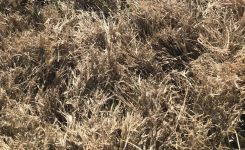Lawn Care Services, Lawn Treatment Solutions Blog
How Can I Avoid Brown Patch Disease on My Tall Fescue Lawn?
How Can I Avoid Brown Patch on My Tall Fescue Lawn?
Between Memorial Day and Labor Day is the optimal time period for the development of Brown Patch disease on Tall Fescue lawns. In this brief article, we’ll explain what Brown Patch is, what causes it, and what you can do to avoid brown patch on your lawn.
What is Brown Patch?
Brown Patch is a fungal disease of the lawn that causes areas of brown grass that are often circular in shape. Brown Patch only affects Tall Fescue lawns; it does not affect Bermuda, Centipede, or Zoysia lawns.
What Causes Brown Patch?
The fungi that cause Brown Patch become active when nighttime temperatures are consistently above 60 degrees and especially so when nighttime temperatures are above 70 degrees. Brown patch is likely to develop when grass blades are continuously wet for 10 to 12 hours.
What Can I Do to Reduce the Risk of Brown Patch on My Lawn?
The high dew points and late-day showers that are common in our climate zone during the summer create prime conditions for the development of Brown Patch within the blades of grass of Tall Fescue. If you are a Crownover Green customer, our treatments will help reduce the risk for disease in your lawn. There are also a couple of important things you can do to further reduce the risk of Brown Patch in your lawn. Specifically, you want to avoid contributing to the environmental moisture within the blades of grass overnight through the summer months.
Water in the Morning. It is essential to water early in the day so that the daytime sun dries the grass blades. Watering just before sunrise ensures that most of the water gets to the roots of the grass with little or no evaporation, and when the sun hits the lawn it helps dry the blades of grass as quickly as possible.
Water Deeply & Infrequently. On the mornings that you water, it is important to water deeply so that the root zone is properly soaked.
Mow weekly at 3.5 inches. Leaving the grass too long may prevent it from drying out as quickly as possible, which potentially increases the risk for Brown Patch. Maintaining it too short through the hot summer will likely stress your cool-season Tall Fescue and make it more susceptible to Brown Patch.
Remember…for Tall Fescue lawns, watering deeply two times per week may be sufficient. When it is exceptionally hot and dry, your lawn may need deep watering three times per week. Watering more frequently than this will increase the likelihood of developing Brown Patch and other fungal diseases.
For more information about how much and how long to water your lawn, check out our previous blog post, It’s Time to Water the Lawn: How Much and How Long








